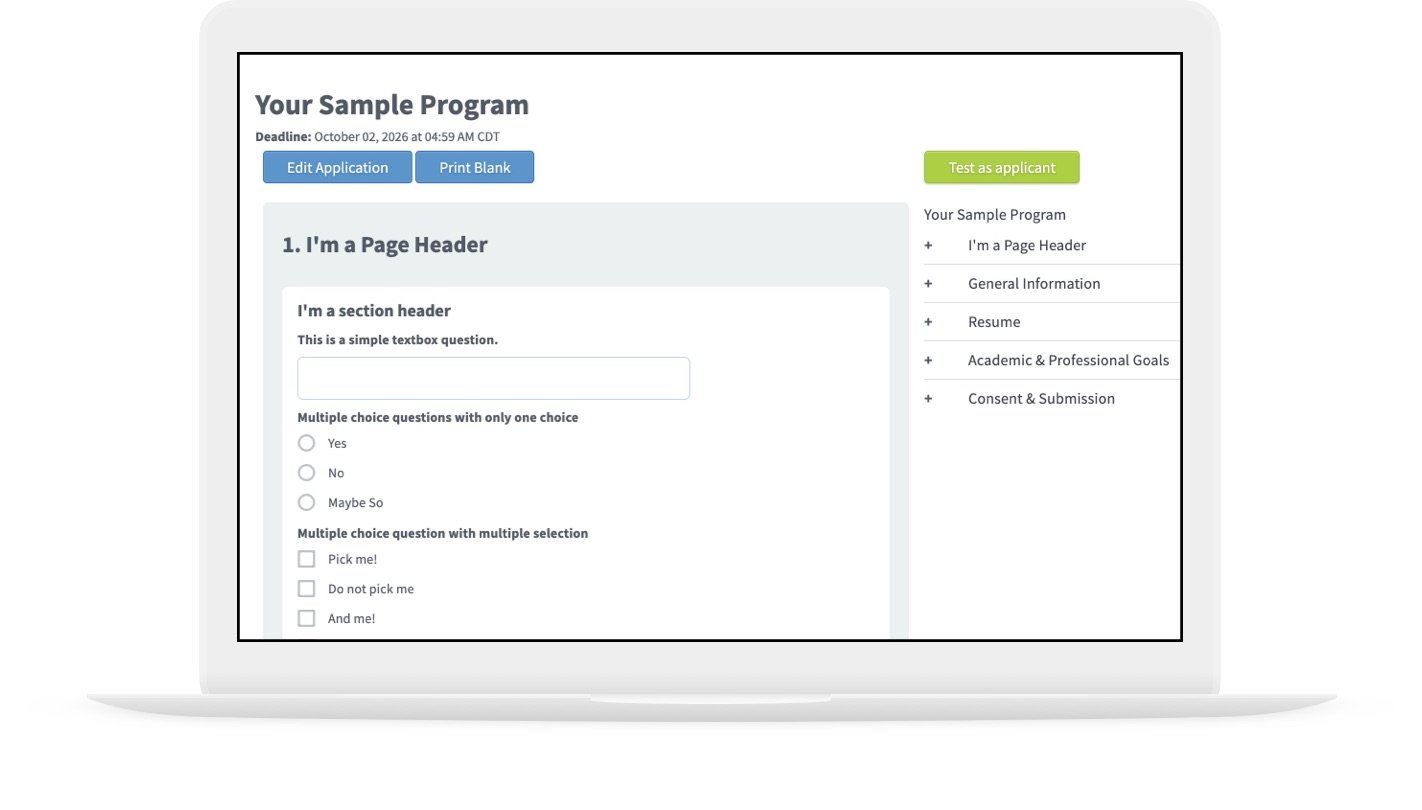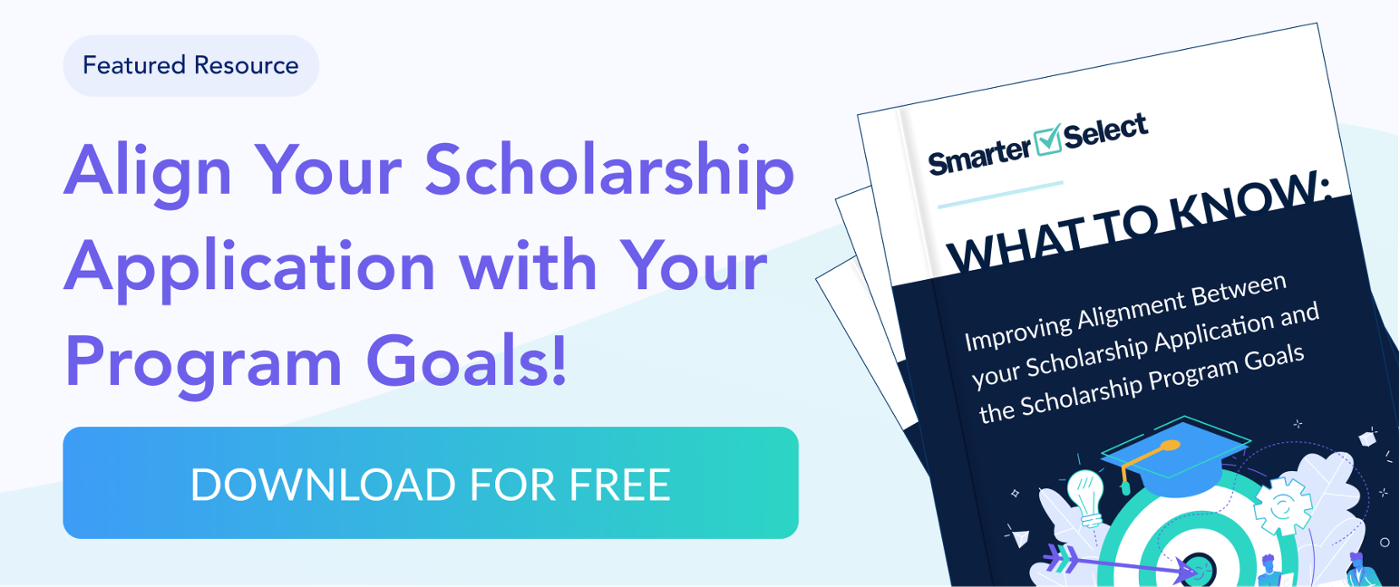How to Build Your Scholarship Application to Reflect Program Goals Effectively
The scholarship application is one of the most essential documents you'll write for your scholarship program. It's also considered one of the most complicated, with a wide variety of forms out there that all seem to ask for different information.
In our previous article, we discussed the importance of establishing goals for your scholarship program, and in this post we’ll explain how to create a scholarship application that reflects those goals effectively. The components needed are to:
- Clearly define eligibility requirements
- Determine what you need to ask before you actually create your form
- Keep it relevant
- Phrase questions in a manner that makes it easy to score, and
- Add an FAQs section
Now that you know the components necessary to create a scholarship application that reflects your goals, let’s break them down further so your scholarship program can bring in more qualified candidates.
Clearly Define Eligibility Requirements
The first to create a scholarship application is to know exactly who can apply and why they are eligible. You want to make sure that every detail on the form matches your previously defined goals. When starting a scholarship application form, ensure that your team understands what each section of your form means so there's no room for confusion or error down the line.
To know exactly what qualifications and demographics you're looking for, start by closely examining the goals of your scholarship. What is it that you want to award? Why do you want to award it? And to whom do you want to grant it?

Once you understand the meaning behind your goals, you can more easily identify who will be eligible and who will not. For example, you may want to direct your scholarship program toward a specific type of student, such as those who cannot afford college tuition and must be fully financially independent while attending school.
Or you might want it to go to people within a particular demographic group, such as women or Hispanic Americans. Finally, you can differentiate students based on their academic or professional interests or accomplishments.
What Should You Ask?
When you create a scholarship application, it's crucial to ask the right questions. Questions should be straightforward and unambiguous, so you don't get mixed or misleading information.
For example, you might also ask applicants to share examples of activities that they're especially proud of. This will give you a better sense of the accomplishments your scholarship winners will most likely achieve.
One thing that may help you figure out what to ask, is looking through the applications of other programs. There may be questions you’re not yet considering, that would help you better ensure your candidates meet your program’s goals.
That’s why it’s so helpful to run your program and build your application with SmarterSelect. Not only do we make it easy to write your form, we give you access to templates, and other program managers to discuss their forms. When you first start searching for how to start a scholarship program, it’s easy to feel isolated, but you’re not alone! Our community forum is worth its weight in gold.

Keep Your Application Questions Relevant
Only ask for the information that you want and need from applicants. You want to make sure that you're not gathering too much information or asking questions that will be irrelevant to the scholarship.
Again, make sure your application is directly connected to your mission and goals: meaning it should ask about things that may help determine who might best succeed with the award.
For example, if your goals are to be awarded based on merits, you might ask students to answer questions about their academic achievements and professional goals. However, if your goal is needs-based, you might ask why they deserve the scholarship, and what they hope to achieve with it.

While you want to ask for appropriate information, you also don't need every detail about someone's life to determine who will be most successful with your scholarship. That said, keep the questions as short and to the point as possible, so applicants can respond quickly using whatever method you have them use.
Include Clear Instructions on How to Answer Questions
It can be frustrating for scholarship applicants to scroll through a lengthy list of questions before getting started. Give them the option to type their responses directly into your application, but also include clear instructions on how you want the information to be entered and displayed.
Use a mix of short and long-form questions so that applicants aren't scrolling through pages of questions when they simply want to answer "yes" or "no." It’s also worth noting that multiple-choice questions are a great way to help guide the applicant and allow for easier auto-scoring. Having questions that can leverage auto-scoring is a great way to get accurate responses and save time.
Once you've completed your application, it's essential to proofread the questions carefully. Make sure there's nothing unclear or misleading about what you're asking applicants to do. You also want to look for any unspoken information in the question that may potentially disqualify an applicant.
Your scholarship application should be designed to look inviting and easy-to-use, so applicants want to complete it. You want a well-thought-out application that communicates your goals clearly and helps you find the best candidate for the award.
Include an FAQ Section
Finally, it's good to include an FAQ section in your scholarship application. This will help answer common questions applicants may have before they start filling out the application. As an added benefit this can save your team countless hours of troubleshooting and corresponding with applicants. It will also give applicants a chance to find more information without going back and forth with you via email or phone call.
SmarterSelect Makes It Easy to Create a Scholarship Application
It’s never been easier to be a scholarship program manager! With SmarterSelect on your side you can get help with everything from creating your form, to developing scoring rubrics, and collecting applications to distribution announcements. Don’t take our word for it though. Kick our tires with a free trial today.
FAQ's
1. How can I create a scholarship application that reflects my scholarship goals effectively?
You can create a scholarship application that reflects your scholarship goals effectively by following the below practices:
- Clearly define eligibility requirements
- Determine what you need to ask before you actually create your form
- Keep it relevant
- Phrase questions in a manner that makes it easy to score, and
- Add an FAQs section.
2. How can I define scholarship eligibility requirements with utmost clarity?
To define scholarship eligibility requirements clearly, you need to closely examine the golas of your scholarship first by asking yourself these three questions:
- What is it that you want to award?
- Why do you want to award it?
- Whom do you want to grant it?
3. What kind of questions should I ask when I create the scholarship application?
You need to keep the questions as short and to the point as possible, so applicants can respond quickly using whatever method you have them use. Your application should ask about things that may help determine who might best succeed with the award.
For example, if your goals are to be awarded based on merits, you might ask students to answer questions about their academic achievements and professional goals.



